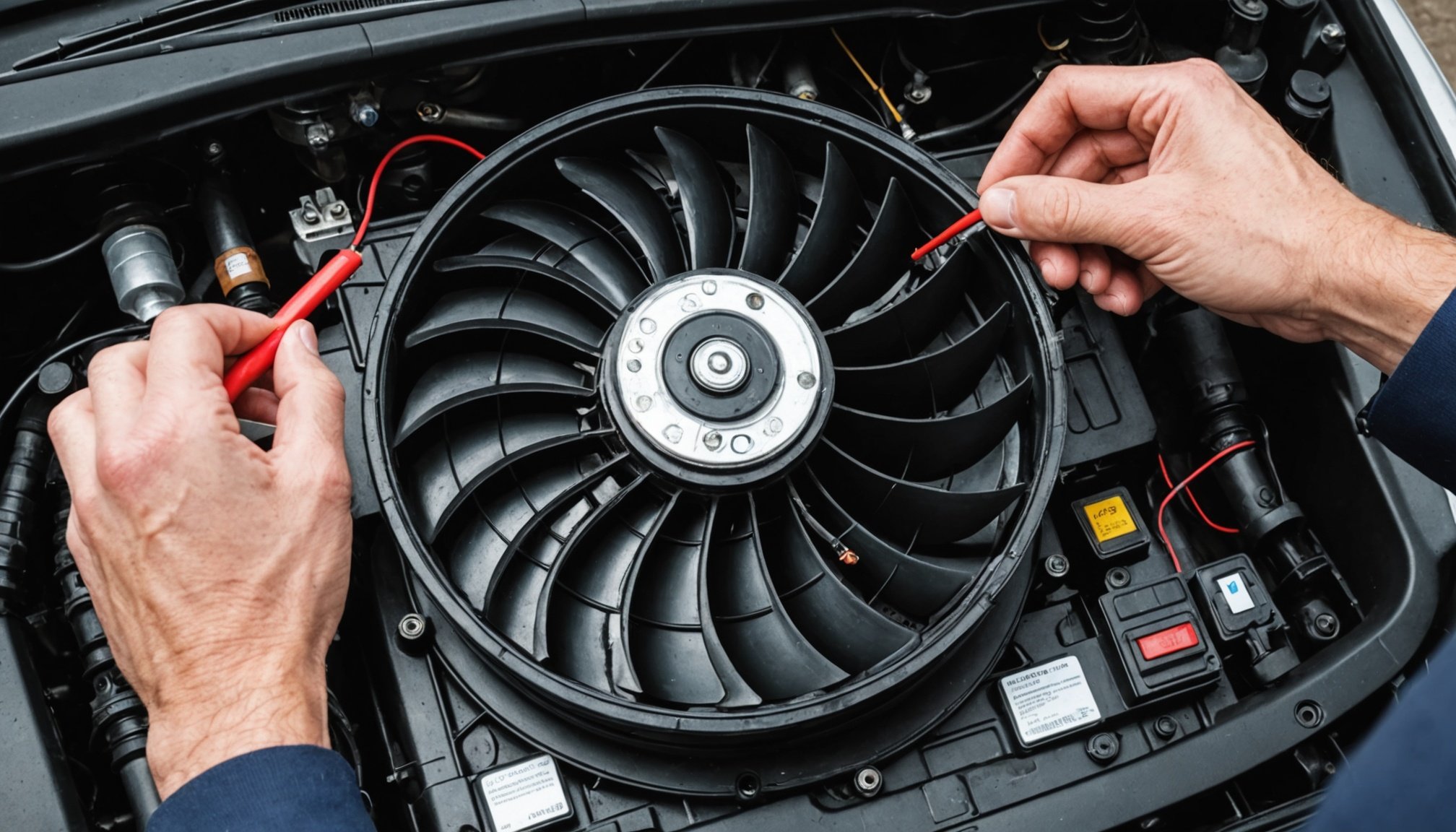Overview of Radiator Fan Functionality
Radiator fans play a crucial role in a vehicle’s cooling system. Their primary function is to prevent engine overheating by regulating the temperature of the engine’s coolant. As the engine runs, the cooling system circulates coolant to absorb heat and dissipate it through the radiator. However, when the vehicle moves slowly or idles, there isn’t enough airflow to cool the radiator effectively. This is where the radiator fan operation becomes essential. It activates to draw additional air through the radiator, maintaining optimum engine temperature.
Understanding the signs of radiator fan malfunction can help prevent serious engine damage. One common indicator is the engine temperature gauge rising beyond normal levels, especially during idling or slow driving. You might also notice unusual noises, such as grinding or rattling, which suggest mechanical issues within the fan itself. In some cases, the check engine light might illuminate, indicating problems within the cooling system.
Also read : Step-by-Step Guide to Safely Replace and Dispose of Your Car Battery in the UK
By ensuring the proper functionality of the radiator fan, you contribute to the vehicle’s overall health, enhancing performance and longevity. Regular maintenance and early diagnostics are pivotal in addressing radiator fan issues before they escalate into costly repairs.
Tools Required for Diagnosing a Radiator Fan
When diagnosing a radiator fan, having the right diagnostic tools is essential. Multimeters and thermal cameras are highly recommended as they help in accurately identifying electrical problems and hotspots. These tools promote precise checks, ensuring no issue goes undetected.
Also read : Step-by-Step Guide: Transitioning Your UK Vehicle to Hydrogen Fuel – Legal and Technical Essentials
Apart from these, other essential tools include basic repair kits, which often contain screwdrivers, pliers, and socket sets. These are necessary for disassembling and reassembling parts of the fan or cooling system. A firm grip and precision are important for making proper adjustments.
Maintenance equipment is equally important during this process. Regular lubricants prevent wear and tear, ensuring your fan operates smoothly. Lubrication should be part of routine maintenance, addressing any potential friction issues that could lead to overheating or noise.
Safety gear is crucial for anyone working with vehicle cooling systems. Personal protective equipment, such as gloves and safety goggles, should be worn at all times to protect against sharp components and unexpected sprays of coolant. Understanding these safety considerations can make maintenance work both safe and effective. With the right tools and safety gear, diagnosing and repairing radiator fans becomes a more manageable process.
Step-by-Step Diagnostic Process
When dealing with radiator fan issues, following structured troubleshooting steps is essential for accurate diagnosis. Begin with initial checks, focusing on examining fuses and wiring connections. A blown fuse or a disconnected wire might be the simple culprits requiring attention.
Next, radiator fan diagnosis entails testing the motor and relay functionality. If these components aren’t working, the system won’t function properly. Listen for clicking sounds from the relay when the fan should activate; absence could indicate a fault needing further investigation.
Using a multimeter is invaluable for practical guidance. First, assess the electrical components by measuring voltage at the fan motor while the engine is running. No voltage could signify a problem upstream, like a faulty switch.
Additional Diagnostic Tips
- Ensure the vehicle is on a flat surface with the engine off when conducting more detailed inspections.
- Use the multimeter to check continuity in wiring; open circuits can often lead to fan failure.
By carefully examining each element and using the multimeter effectively, these steps should illuminate where discrepancies lie, potentially saving the hassle of costlier vehicle repairs.
Common Faults in Radiator Fans
Radiator fans are crucial for maintaining a vehicle’s temperature, but like any component, they can encounter typical issues. One frequent radiator fan problem is blade damage. This can range from cracks due to physical impact to wear over time, which reduces efficiency. Additionally, motor failure is a prevalent failure mode, often resulting from electrical faults or general wear and tear.
Faulty sensors also play a significant role in degrading radiator fan performance. Sensors are responsible for detecting temperature changes and instructing the fan to operate when needed. If these sensors fail or provide incorrect readings, it can lead to improper fan operation, causing the engine to overheat.
Climate control systems in vehicles can influence radiator fan issues too. For instance, an inadequately functioning vehicle air conditioning system can result in the radiator fan overworking to compensate for a lack of cooling, leading to premature wear. By understanding these common problems, vehicle owners can better diagnose and potentially avoid costly repairs. Regular maintenance and inspections can mitigate these faults, ensuring the radiator fan operates effectively and extends the vehicle’s lifespan.
Repair Techniques for Radiator Fan Problems
Radiator fan issues can lead to engine overheating if not properly addressed. Explore these repair techniques to resolve radiator fan repair challenges effectively and ensure smooth vehicle operation.
Fixing Issues with the Fan Motor
Begin by examining the fan motor. If it’s faulty, a step-by-step approach is crucial:
- Disconnect the battery to prevent any electrical mishaps.
- Locate the fan motor and carefully detach it from its housing.
- Inspect for physical damage or wear. If necessary, replace it with a new motor.
- Reattach the motor securely and reconnect the electrical connections.
Addressing Faulty Wiring and Connections
Wiring problems can hinder fan functionality. Follow these maintenance procedures:
- Check all wiring for signs of damage or corrosion.
- Secure any loose connections and replace damaged wires.
- Ensure that power is reaching the fan by using a multimeter to verify voltage.
When to Seek Professional Help
Complex repairs may require professional intervention. It’s wise to consult a technician if:
- The fan exhibits erratic operation after initial troubleshooting.
- Both the motor and wiring appear functional yet the issue persists.
By following these guidelines, you’ll be well-equipped to tackle radiator fan problems with confidence.
Preventative Maintenance for Radiator Fans
Proper radiator fan maintenance is crucial for ensuring the longevity of your vehicle’s cooling system. Regular inspection practices are essential in maintaining the functionality and efficiency of the radiator fan, which plays a pivotal role in preventing engine overheating.
Start with visual inspections to check for any physical damage like cracks or chips on the fan blades. Listen for unusual noises during operation, which could indicate mechanical issues. Identifying issues early through these checks helps prevent costly repairs.
The cleanliness of the cooling system is equally important. Dirt and debris can accumulate on the fan, impeding airflow, so regular cleaning with a gentle brush or compressed air is recommended.
Routine checks should be tailored to your vehicle’s specific needs. Generally, inspecting the radiator fan every 10,000 to 15,000 miles is advisable. However, those who drive in harsh conditions, such as extreme heat or off-road, may need to adjust these intervals. Refer to the vehicle’s manual for precise guidance.
Incorporating these upkeep practices can significantly extend the life of your vehicle. Keeping your radiator fan in optimal condition ensures efficient performance, minimizing the risk of overheating and contributing to your car’s overall durability.
Local Considerations for UK Vehicle Owners
When considering radiator fan replacement for cars in the UK, it’s essential to understand how UK vehicle regulations impact the process. Regulations can dictate the specific requirements for parts and installation to ensure safety and efficiency. Compliance with these rules isn’t just mandatory; it contributes to vehicle performance and longevity.
In the UK, certain vehicle models are more prevalent, and understanding how these models interact with radiator fans is critical. For instance, local brands and popular imports often present distinct challenges regarding compatibility issues. Some brands may experience recurring radiator fan failures due to design quirks or operational demands. This necessitates attention to specific vehicle characteristics when selecting a replacement.
Moreover, sourcing parts compliant with UK automotive standards is vital. Parts must meet quality and safety benchmarks to be legally used in vehicles. This ensures that radiator fans installed in UK vehicles operate efficiently under the unique driving conditions of the region. Consider using local brands proficient in producing standard-compliant parts that seamlessly integrate with current systems. These careful considerations will help mitigate the risks of compatibility issues, ensuring a smoother and more reliable transition.
Illustrations and Flowcharts for Troubleshooting
Navigating the complexities of vehicle diagnostics can be daunting, but using troubleshooting flowcharts offers a structured, visual guide to simplify this process. These flowcharts provide a step-by-step diagnostic approach, allowing even beginners to follow a systematic path to identify issues accurately. By breaking down complex problems into manageable steps, they act as an invaluable resource.
In addition to troubleshooting flowcharts, visual guidance through diagrams greatly aids in understanding, particularly with UK’s diverse vehicle wiring layouts. These diagnostic diagrams not only illustrate different wiring systems but also highlight common issues, making it easier for users to pinpoint faults. As automotive systems can be intricate, having a visual representation helps demystify wiring paths and connections, resulting in more effective problem-solving.
Moreover, when dealing with automotive cooling systems, illustrations play a crucial role. They offer insights into the intricate components and operations, which textual descriptions alone cannot achieve. By enhancing the understanding of how these systems should function, users can better detect and address malfunctions. Overall, leveraging visuals can significantly enhance one’s learning and diagnostic capabilities, making vehicle maintenance more accessible and effective.











